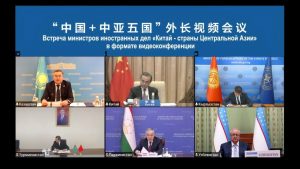On July 16, 2020, China held its first meeting with the foreign ministers of all five Central Asian countries in the “5+1” format. The meeting was reportedly initiated by Beijing and focused on joint cooperation to fight the pandemic and restoring the economies in the region. For decades, China had been pursuing relations bilaterally with these countries, or within the context of larger regional groupings that included Russia, like the Shanghai Cooperation Organization. With its 5+1 China has graduated to a more narrow regional arrangement. Beijing might have sensed an opportune moment to increase its clout in the region as the health systems of the Central Asian countries are overwhelmed and their economies are under stress.
During the online meeting, China announced its readiness to offer a green corridor for its products into Central Asia and to purchase more agriculture products from the region. Feeling the economic pinch and health crisis as a result of a second wave of COVID-19 cases, the Central Asian countries are turning to Beijing for assistance.
The “5+1” format, in which Central Asia states hold regular meetings with a single country outside the region, is not a new arrangement. Japan was the first country to institute such a cooperative format in 2004, followed by South Korea, the European Union, the United States, and now China.
Despite the delay in adopting the “5+1” format, China has had a prominent presence in the economies of the region for decades. In trade relations, China is the most prominent or second most prominent partner. China is also a major investor in physical and digital infrastructure in the region. Nevertheless, Beijing long preferred bilateral relations in dealing with the region. Regional meetings are not new necessarily, as the countries regularly meet in the framework of Belt and Road Initiative (BRI) and Shanghai Cooperation Organization (SCO), but those meetings are not confined solely to the five Central Asian countries and China.
In the past, any reference to “Central Asia-China” would mean economic cooperation, namely a network of gas pipelines (including three finished pipelines and a fourth in the process of construction) that start in Turkmenistan and pass through the territories of the countries in the region. Now “Central Asia-China” will mean political cooperation as well.
Providing reassurance to Central Asian states that China is still interested in the region despite slowed economic activity could be one of the explanations why Beijing launched such a regional cooperation effort now. Another reason could be that China’s relations with a number of world powers have soured, in part over its mishandling of the early COVID-19 outbreak, motivating Beijing to shift attention to friendly countries to strengthen its support network. Beijing’s treatment of Uyghurs and other Turkic minorities is also gaining increased attention and scrutiny around the world, and China possibly needs reassurance from the leaders of Central Asia that their population will not sympathize with the culturally and linguistically close neighbors across the border.
Another important aspect of launching its effort at tighter regional cooperation is that in February 2020, after the Central Asia-U.S. “5+1” meeting, Beijing accused the United States of slander and stoking discord between Central Asia and China. The statement further read that Beijing was confident that its Central Asian colleagues shared an extreme aversion to Secretary Mike Pompeo’s behavior and blackmail. It was a rare and daring moment for Beijing to clash with Washington over Central Asia, but China showed that it would not discriminate between picking small or big fights to defend its interests.
The first regional meeting between the Central Asian states and China marks a smooth graduation from mainly economic relations with the region to more political relations. Economic relations under the BRI and security relations under the SCO will now be reinforced by political relations under the Central Asia-China meetings. The creation of the new format is an expansion of China’s role in the region and a signal of its readiness to compete for influence in the region when needed.

































